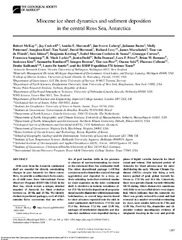| dc.contributor.author | McKay, Robert | |
| dc.contributor.author | Cockrell, Jay | |
| dc.contributor.author | Shevenell, Amelia E. | |
| dc.contributor.author | Laberg, Jan Sverre | |
| dc.contributor.author | Burns, Julianne | |
| dc.contributor.author | Patterson, Molly | |
| dc.contributor.author | Kim, Sunghan | |
| dc.contributor.author | Naish, Tim | |
| dc.contributor.author | Harwood, David | |
| dc.contributor.author | Levy, Richard | |
| dc.contributor.author | Marschalek, James | |
| dc.contributor.author | van de Flierdt, Tina | |
| dc.contributor.author | Ishino, Saki | |
| dc.contributor.author | Keisling, Benjamin | |
| dc.contributor.author | Moreno Cordeiro de Sousa, Isabel | |
| dc.contributor.author | Cortese, Giuseppe | |
| dc.contributor.author | Sangiorgi, Francesca | |
| dc.contributor.author | Leckie, R. Mark | |
| dc.contributor.author | Dodd, Justin | |
| dc.contributor.author | Duncan, Bella | |
| dc.contributor.author | Pérez, Lara F. | |
| dc.contributor.author | Romans, Brian W. | |
| dc.contributor.author | Kim, Sookwan | |
| dc.contributor.author | Bombard, Samantha | |
| dc.contributor.author | Browne, Imogen | |
| dc.contributor.author | van Peer, Tim | |
| dc.contributor.author | Seki, Osamu | |
| dc.contributor.author | Colleoni, Florence | |
| dc.contributor.author | Kulhanek, Denise | |
| dc.contributor.author | De Santis, Laura | |
| dc.date.accessioned | 2025-03-18T10:08:49Z | |
| dc.date.available | 2025-03-18T10:08:49Z | |
| dc.date.issued | 2024-10-09 | |
| dc.description.abstract | Drill cores from the Antarctic continental shelf are essential for directly constraining changes in past Antarctic Ice Sheet extent. Here, we provide a sedimentary facies analysis of drill cores from International Ocean Discovery Program (IODP) Site U1521 in the Ross Sea, which reveals a unique, detailed snapshot of Antarctic Ice Sheet evolution between ca. 18 Ma and 13 Ma. We identify distinct depositional packages, each of which contains facies successions that are reflective of past baseline shifts in the presence or absence of marine-terminating ice sheets on the outermost Ross Sea continental shelf. The oldest depositional package (>18 Ma) contains massive diamictites stacked through aggradation and deposited in a deep, actively subsiding basin that restricted marine ice sheet expansion on the outer continental shelf. A slowdown in tectonic subsidence after 17.8 Ma led to the deposition of progradational massive diamictites with thin mudstone beds/laminae, as several large marine-based ice sheet advances expanded onto the mid- to outer continental shelf between 17.8 Ma and 17.4 Ma. Between 17.2 Ma and 15.95 Ma, packages of interbedded diamictite and diatom-rich mudstone were deposited during a phase of highly variable Antarctic Ice Sheet extent and volume. This included periods of Antarctic Ice Sheet advance near the outer shelf during the early Miocene Climate Optimum (MCO)—despite this being a well-known period of peak global warmth between ca. 17.0 Ma and 14.6 Ma. Conversely, there were periods of peak warmth within the MCO during which diatom-rich mudstones with little to no ice-rafted debris were deposited, which indicates that the Antarctic Ice Sheet was greatly reduced in extent and had retreated to a smaller terrestrial-terminating ice sheet, most notably between 16.3 Ma and 15.95 Ma. Post-14.2 Ma, diamictites and diatomites contain unambiguous evidence of subglacial shearing in the core and provide the first direct, well-dated evidence of highly erosive marine ice sheets on the outermost continental shelf during the onset of the Middle Miocene Climate Transition (MMCT; 14.2–13.6 Ma). Although global climate forcings and feedbacks influenced Antarctic Ice Sheet advances and retreats during the MCO and MMCT, we propose that this response was nonlinear and heavily influenced by regional feedbacks related to the shoaling of the continental shelf due to reduced subsidence, sediment infilling, and local sea-level changes that directly influenced oceanic influences on melting at the Antarctic Ice Sheet margin. Although intervals of diatom-rich muds and diatomite indicating open-marine interglacial conditions still occurred during (and following) the MMCT, repeated advances of marine-based ice sheets since that time have resulted in widespread erosion and overdeepening in the inner Ross Sea, which has greatly enhanced sensitivity to marine ice sheet instability since 14.2 Ma. | en_US |
| dc.identifier.citation | McKay R, Cockrell, Shevenell AE, Laberg JS. Miocene ice sheet dynamics and sediment deposition in the central Ross Sea, Antarctica. Geological Society of America Bulletin. 2024;137(3-4):1267-1291 | en_US |
| dc.identifier.cristinID | FRIDAID 2367022 | |
| dc.identifier.doi | 10.1130/B37613.1 | |
| dc.identifier.issn | 0016-7606 | |
| dc.identifier.issn | 1943-2674 | |
| dc.identifier.uri | https://hdl.handle.net/10037/36713 | |
| dc.language.iso | eng | en_US |
| dc.publisher | The Geological Society of America | en_US |
| dc.relation.journal | Geological Society of America Bulletin | |
| dc.relation.projectID | info:eu-repo/grantAgreement/EC/H2020/792773/EU/West Antarctic Margin Signatures of Ice Sheet Evolution/WAMSISE/ | en_US |
| dc.rights.accessRights | openAccess | en_US |
| dc.rights.holder | Copyright 2024 The Author(s) | en_US |
| dc.rights.uri | https://creativecommons.org/licenses/by/4.0 | en_US |
| dc.rights | Attribution 4.0 International (CC BY 4.0) | en_US |
| dc.title | Miocene ice sheet dynamics and sediment deposition in the central Ross Sea, Antarctica | en_US |
| dc.type.version | publishedVersion | en_US |
| dc.type | Journal article | en_US |
| dc.type | Tidsskriftartikkel | en_US |
| dc.type | Peer reviewed | en_US |


 English
English norsk
norsk
